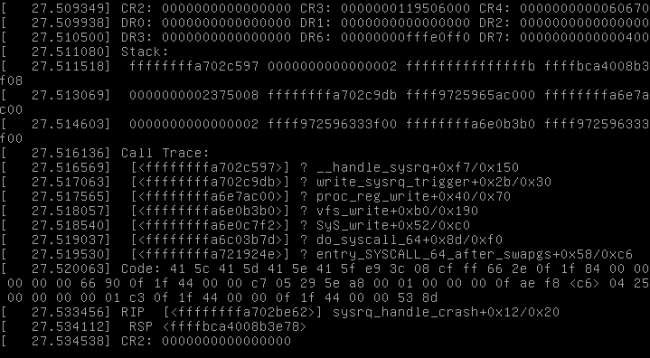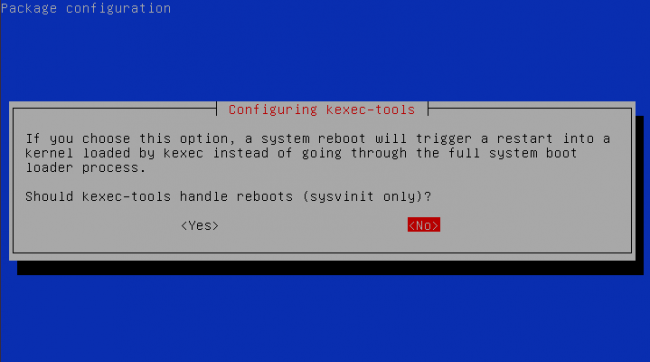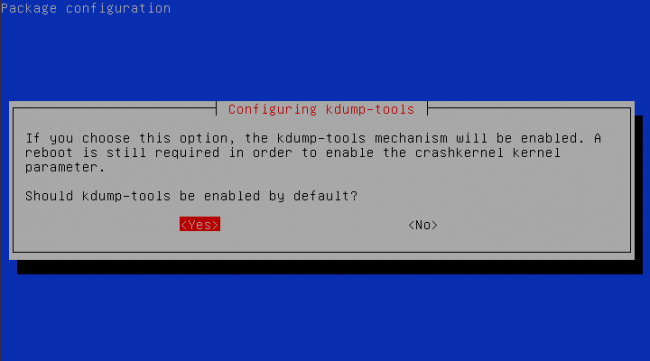Oops! Debugging Kernel Panics

A look into what causes kernel panics and some utilities to help gain more information.
Working in a Linux environment, how often have you seen a kernel panic? When it happens, your system is left in a crippled state until you reboot it completely. And, even after you get your system back into a functional state, you're still left with the question: why? You may have no idea what happened or why it happened. Those questions can be answered though, and the following guide will help you root out the cause of some of the conditions that led to the original crash.

Figure 1. A Typical Kernel Panic
Let's start by looking at a set of utilities known as
kexec and kdump. kexec allows you to boot into
another kernel from an existing (and running) kernel, and
kdump is a
kexec-based crash-dumping mechanism for Linux.
Installing the Required Packages
First and foremost, your kernel should have the following components statically built in to its image:
CONFIG_RELOCATABLE=y
CONFIG_KEXEC=y
CONFIG_CRASH_DUMP=y
CONFIG_DEBUG_INFO=y
CONFIG_MAGIC_SYSRQ=y
CONFIG_PROC_VMCORE=y
You can find this in /boot/config-`uname -r`.
Make sure that your operating system is up to date with the latest-and-greatest package versions:
$ sudo apt update && sudo apt upgrade
Install the following packages (I'm currently using Debian, but the same should and will apply to Ubuntu):
$ sudo apt install gcc make binutils linux-headers-`uname -r`
↪kdump-tools crash `uname -r`-dbg
Note: Package names may vary across distributions.
During the installation, you will be prompted with questions to enable
kexec to handle reboots (answer whatever you'd like, but I answered
"no"; see Figure 2).

Figure 2. kexec Configuration Menu
And to enable kdump to run and load at system boot, answer
"yes" (Figure 3).

Figure 3. kdump Configuration Menu
Configuring kdump
Open the /etc/default/kdump-tools file, and at the very top, you should see the following:
USE_KDUMP=1
#KDUMP_SYSCTL="kernel.panic_on_oops=1"
Eventually, you'll write a custom module that will trigger an OOPS kernel
condition, and in order to have kdump gather and save the state of the
system for post-mortem analysis, you'll need to enable your kernel to
panic on this OOPS condition. In order to do this, uncomment the line
that starts with KDUMP_SYSCTL:
USE_KDUMP=1
KDUMP_SYSCTL="kernel.panic_on_oops=1"
The initial testing will require that SysRq be enabled. There are a few ways to do that, but here I provide instructions to enable support for this feature on system reboot. Open the /etc/sysctl.d/99-sysctl.conf file, and make sure that the following line (closer to the bottom of the file) is uncommented:
kernel.sysrq=1
Now, open this file: /etc/default/grub.d/kdump-tools.default. You will find a single line that looks like this:
GRUB_CMDLINE_LINUX_DEFAULT="$GRUB_CMDLINE_LINUX_DEFAULT
↪crashkernel=384M-:128M"
Modify the section that reads crashkernel=384M-:128M to
crashkernel=128M.
Now, update your GRUB boot configuration file:
$ sudo update-grub
[sudo] password for petros:
Generating grub configuration file ...
Found linux image: /boot/vmlinuz-4.9.0-8-amd64
Found initrd image: /boot/initrd.img-4.9.0-8-amd64
done
And, reboot the system.
Verifying Your kdump Environment
After coming back from the reboot, dmesg will log the
following:
$ sudo dmesg |grep -i crash
[ 0.000000] Command line: BOOT_IMAGE=/boot/vmlinuz-4.9.0-8-amd64
↪root=UUID=bd76b0fe-9d09-40a9-a0d8-a7533620f6fa ro quiet
↪crashkernel=128M
[ 0.000000] Reserving 128MB of memory at 720MB for crashkernel
↪(System RAM: 4095MB)
[ 0.000000] Kernel command line: BOOT_IMAGE=/boot/
↪vmlinuz-4.9.0-8-amd64
↪root=UUID=bd76b0fe-9d09-40a9-a0d8-a7533620f6fa ro
↪quiet crashkernel=128M
While your kernel will have the following features enabled (a "1" means enabled):
$ sudo sysctl -a|grep kernel|grep -e panic_on_oops -e sysrq
kernel.panic_on_oops = 1
kernel.sysrq = 1
Your kdump service should be running:
$ sudo systemctl status kdump-tools.service
kdump-tools.service - Kernel crash dump capture service
Loaded: loaded (/lib/systemd/system/kdump-tools.service;
↪enabled; vendor preset: enabled)
Active: active (exited) since Tue 2019-02-26 08:13:34 CST;
↪1h 33min ago
Process: 371 ExecStart=/etc/init.d/kdump-tools start
↪(code=exited, status=0/SUCCESS)
Main PID: 371 (code=exited, status=0/SUCCESS)
Tasks: 0 (limit: 4915)
CGroup: /system.slice/kdump-tools.service
Feb 26 08:13:34 deb-panic systemd[1]: Starting Kernel crash
↪dump capture service...
Feb 26 08:13:34 deb-panic kdump-tools[371]: Starting
↪kdump-tools: loaded kdump kernel.
Feb 26 08:13:34 deb-panic kdump-tools[505]: /sbin/kexec -p
↪--command-line="BOOT_IMAGE=/boot/vmlinuz-4.9.0-8-amd64 root=
Feb 26 08:13:34 deb-panic kdump-tools[506]: loaded kdump kernel
Feb 26 08:13:34 deb-panic systemd[1]: Started Kernel crash dump
↪capture service.
Your crash kernel should be loaded (into memory and in the 128M region you defined earlier):
$ cat /sys/kernel/kexec_crash_loaded
1
You can verify your kdump configuration further here:
$ sudo kdump-config show
DUMP_MODE: kdump
USE_KDUMP: 1
KDUMP_SYSCTL: kernel.panic_on_oops=1
KDUMP_COREDIR: /var/crash
crashkernel addr: 0x2d000000
/var/lib/kdump/vmlinuz: symbolic link to /boot/
↪vmlinuz-4.9.0-8-amd64
kdump initrd:
/var/lib/kdump/initrd.img: symbolic link to /var/lib/kdump/
↪initrd.img-4.9.0-8-amd64
current state: ready to kdump
kexec command:
/sbin/kexec -p --command-line="BOOT_IMAGE=/boot/
↪vmlinuz-4.9.0-8-amd64 root=UUID=bd76b0fe-9d09-40a9-
↪a0d8-a7533620f6fa ro quiet irqpoll nr_cpus=1 nousb
↪systemd.unit=kdump-tools.service
↪ata_piix.prefer_ms_hyperv=0"
↪--initrd=/var/lib/kdump/initrd.img /var/lib/kdump/vmlinuz
Let's also test it without actually running it:
$ sudo kdump-config test
USE_KDUMP: 1
KDUMP_SYSCTL: kernel.panic_on_oops=1
KDUMP_COREDIR: /var/crash
crashkernel addr: 0x2d000000
kdump kernel addr:
kdump kernel:
/var/lib/kdump/vmlinuz: symbolic link to /boot/
↪vmlinuz-4.9.0-8-amd64
kdump initrd:
/var/lib/kdump/initrd.img: symbolic link to
↪/var/lib/kdump/initrd.img-4.9.0-8-amd64
kexec command to be used:
/sbin/kexec -p --command-line="BOOT_IMAGE=/boot/
↪vmlinuz-4.9.0-8-amd64 root=UUID=bd76b0fe-9d09-40a9-
↪a0d8-a7533620f6fa ro quiet irqpoll nr_cpus=1 nousb
↪systemd.unit=kdump-tools.service
↪ata_piix.prefer_ms_hyperv=0"
↪--initrd=/var/lib/kdump/initrd.img /var/lib/kdump/vmlinuz
The Moment of Truth
Now that your environment is loaded to make use of kdump, you
probably should test it, and the best way to test it is by forcing a
kernel crash over SysRq. Assuming your kernel is built with SysRq support,
crashing a running kernel is as simple as typing:
$ echo "c" | sudo tee -a /proc/sysrq-trigger
What should you expect? You'll see a kernel panic/crash similar to the one shown in Figure 1. Following this crash, the kernel loaded over kexec will collect the state of the system, which includes everything relevant in memory, on the CPU, in dmesg, in loaded modules and more. It then will save this valuable crash data somewhere in /var/crash for further analysis. Once the collection of information completes, the system will reboot automatically and will bring you back to a functional state.
What Now?
You now have your crash file, and again, it's located in /var/crash:
$ cd /var/crash/
$ ls
201902261006 kexec_cmd
$ cd 201902261006/
Although before opening the crash file, you probably should install the kernel's source package:
$ sudo apt source linux-image-`uname -r`
Earlier, you installed a debug version of your Linux kernel containing
the unstripped debug symbols required for this type of debugging
analysis. Now you need that kernel. Open the kernel crash file with the
crash utility:
$ sudo crash dump.201902261006 /usr/lib/debug/
↪vmlinux-4.9.0-8-amd64
Once everything loads, a summary of the panic will appear on the screen:
KERNEL: /usr/lib/debug/vmlinux-4.9.0-8-amd64
DUMPFILE: dump.201902261006 [PARTIAL DUMP]
CPUS: 4
DATE: Tue Feb 26 10:07:21 2019
UPTIME: 00:04:09
LOAD AVERAGE: 0.00, 0.00, 0.00
TASKS: 100
NODENAME: deb-panic
RELEASE: 4.9.0-8-amd64
VERSION: #1 SMP Debian 4.9.144-3 (2019-02-02)
MACHINE: x86_64 (2592 Mhz)
MEMORY: 4 GB
PANIC: "sysrq: SysRq : Trigger a crash"
PID: 563
COMMAND: "tee"
TASK: ffff88e69628c080 [THREAD_INFO: ffff88e69628c080]
CPU: 2
STATE: TASK_RUNNING (SYSRQ)
Notice the reason for the panic: sysrq: SysRq : Trigger
a crash. Also, notice the command that led to it:
tee. None of this should be a surprise since you
triggered it.
If you run a backtrace of what the kernel functions were that led to the panic, you should see the following (processed by CPU core no. 2):
crash> bt
PID: 563 TASK: ffff88e69628c080 CPU: 2 COMMAND: "tee"
#0 [ffffa67440b23ba0] machine_kexec at ffffffffa0c53f68
#1 [ffffa67440b23bf8] __crash_kexec at ffffffffa0d086d1
#2 [ffffa67440b23cb8] crash_kexec at ffffffffa0d08738
#3 [ffffa67440b23cd0] oops_end at ffffffffa0c298b3
#4 [ffffa67440b23cf0] no_context at ffffffffa0c619b1
#5 [ffffa67440b23d50] __do_page_fault at ffffffffa0c62476
#6 [ffffa67440b23dc0] page_fault at ffffffffa121a618
[exception RIP: sysrq_handle_crash+18]
RIP: ffffffffa102be62 RSP: ffffa67440b23e78 RFLAGS: 00010282
RAX: ffffffffa102be50 RBX: 0000000000000063 RCX: 0000000000000000
RDX: 0000000000000000 RSI: ffff88e69fd10648 RDI: 0000000000000063
RBP: ffffffffa18bf320 R8: 0000000000000001 R9: 0000000000007eb8
R10: 0000000000000001 R11: 0000000000000001 R12: 0000000000000004
R13: 0000000000000000 R14: 0000000000000000 R15: 0000000000000000
ORIG_RAX: ffffffffffffffff CS: 0010 SS: 0018
#7 [ffffa67440b23e78] __handle_sysrq at ffffffffa102c597
#8 [ffffa67440b23ea0] write_sysrq_trigger at ffffffffa102c9db
#9 [ffffa67440b23eb0] proc_reg_write at ffffffffa0e7ac00
#10 [ffffa67440b23ec8] vfs_write at ffffffffa0e0b3b0
#11 [ffffa67440b23ef8] sys_write at ffffffffa0e0c7f2
#12 [ffffa67440b23f38] do_syscall_64 at ffffffffa0c03b7d
#13 [ffffa67440b23f50] entry_SYSCALL_64_after_swapgs at ffffffffa121924e
RIP: 00007f3952463970 RSP: 00007ffc7f3a4e58 RFLAGS: 00000246
RAX: ffffffffffffffda RBX: 0000000000000002 RCX: 00007f3952463970
RDX: 0000000000000002 RSI: 00007ffc7f3a4f60 RDI: 0000000000000003
RBP: 00007ffc7f3a4f60 R8: 00005648f508b610 R9: 00007f3952944480
R10: 0000000000000839 R11: 0000000000000246 R12: 0000000000000002
R13: 0000000000000001 R14: 00005648f508b530 R15: 0000000000000002
ORIG_RAX: 0000000000000001 CS: 0033 SS: 002b
In your backtrace, you should notice the symbol address of what is stored in
your Return Instruction Pointer (RIP): ffffffffa102be62. Let's take a look at this symbol address:
crash> sym ffffffffa102be62
ffffffffa102be62 (t) sysrq_handle_crash+18 ./debian/build/
↪build_amd64_none_amd64/./drivers/tty/sysrq.c: 144
Wait a minute! The exception seems to have been triggered in line 144
of the drivers/tty/sysrq.c file and inside the
sysrq_handle_crash function. Hmm...I wonder what's happening
in this kernel source file. (This is why I had you installed your kernel source
package moments ago.) Let's navigate to the /usr/src
directory and untar the source package:
$ cd /usr/src
$ ls
linux_4.9.144-3.debian.tar.xz linux_4.9.144.orig.tar.xz
↪linux-headers-4.9.0-8-common
linux_4.9.144-3.dsc linux-headers-4.9.0-8-amd64
↪linux-kbuild-4.9
$ sudo tar xJf linux_4.9.144.orig.tar.xz
$ vim linux-4.9.144/drivers/tty/sysrq.c
Locate the sysrq_handle_crash function:
static void sysrq_handle_crash(int key)
{
char *killer = NULL;
/* we need to release the RCU read lock here,
* otherwise we get an annoying
* 'BUG: sleeping function called from invalid context'
* complaint from the kernel before the panic.
*/
rcu_read_unlock();
panic_on_oops = 1; /* force panic */
wmb();
*killer = 1;
}
And more specifically, look at line 144:
*killer = 1;
It was this line that led to the page fault logged in line #6 of the backtrace:
#6 [ffffa67440b23dc0] page_fault at ffffffffa121a618
Okay. So, now you should have a basic understanding of how to debug bad kernel code, but what happens if you want to debug your very own custom kernel modules (for example, drivers)? I wrote a simple Linux kernel module that essentially invokes a similar style of a kernel crash when loaded. Call it test-module.c and save it somewhere in your home directory:
#include <linux/init.h>
#include <linux/module.h>
#include <linux/version.h>
static int test_module_init(void)
{
int *p = 1;
printk("%d\n", *p);
return 0;
}
static void test_module_exit(void)
{
return;
}
module_init(test_module_init);
module_exit(test_module_exit);
You'll need a Makefile to compile this kernel module (save it in the same directory):
obj-m += test-module.o
all:
$(MAKE) -C/lib/modules/$(shell uname -r)/build M=$(PWD)
Run the make command to compile the module and do
not delete any of the compilation artifacts; you'll need
those later:
$ make
make -C/lib/modules/4.9.0-8-amd64/build M=/home/petros
make[1]: Entering directory '/usr/src/
↪linux-headers-4.9.0-8-amd64'
CC [M] /home/petros/test-module.o
/home/petros/test-module.c: In function "test_module_init":
/home/petros/test-module.c:7:11: warning: initialization makes
↪pointer from integer without a cast [-Wint-conversion]
int *p = 1;
^
Building modules, stage 2.
MODPOST 1 modules
LD [M] /home/petros/test-module.ko
make[1]: Leaving directory '/usr/src/
↪linux-headers-4.9.0-8-amd64'
Note: you may see a compilation warning. Ignore it for now. This warning will be what triggers your kernel crash.
Be careful now. Once you load the .ko file, the system will crash, so make sure everything is saved and synchronized to disk:
$ sync && sudo insmod test-module.ko
Similar to before, the system will crash, the kexec
kernel/environment will help gather everything and save it somewhere in
/var/crash, followed by an automatic reboot. After you have
rebooted and are back into a functional state, locate the new crash
directory and change into it:
$ cd /var/crash/201902261035/
Also, copy the unstripped kernel object file for your test-module from
your home directory and into the current working directory:
$ sudo cp ~/test.o /var/crash/201902261035/
Load the crash file with your debug kernel:
$ sudo crash dump.201902261035 /usr/lib/debug/
↪vmlinux-4.9.0-8-amd64
Your summary should look something like this:
KERNEL: /usr/lib/debug/vmlinux-4.9.0-8-amd64
DUMPFILE: dump.201902261035 [PARTIAL DUMP]
CPUS: 4
DATE: Tue Feb 26 10:37:47 2019
UPTIME: 00:11:16
LOAD AVERAGE: 0.24, 0.06, 0.02
TASKS: 102
NODENAME: deb-panic
RELEASE: 4.9.0-8-amd64
VERSION: #1 SMP Debian 4.9.144-3 (2019-02-02)
MACHINE: x86_64 (2592 Mhz)
MEMORY: 4 GB
PANIC: "BUG: unable to handle kernel NULL pointer
↪dereference at 0000000000000001"
PID: 1493
COMMAND: "insmod"
TASK: ffff893c5a5a5080 [THREAD_INFO: ffff893c5a5a5080]
CPU: 3
STATE: TASK_RUNNING (PANIC)
The reason for the kernel crash is summarized as follows:
BUG: unable to handle kernel NULL pointer dereference at
0000000000000001. The userspace command that led to the panic
was your insmod.
A backtrace will reveal a page fault exception at address
ffffffffc05ed005:
crash> bt
PID: 1493 TASK: ffff893c5a5a5080 CPU: 3 COMMAND: "insmod"
#0 [ffff9dcd013b79f0] machine_kexec at ffffffffa3a53f68
#1 [ffff9dcd013b7a48] __crash_kexec at ffffffffa3b086d1
#2 [ffff9dcd013b7b08] crash_kexec at ffffffffa3b08738
#3 [ffff9dcd013b7b20] oops_end at ffffffffa3a298b3
#4 [ffff9dcd013b7b40] no_context at ffffffffa3a619b1
#5 [ffff9dcd013b7ba0] __do_page_fault at ffffffffa3a62476
#6 [ffff9dcd013b7c10] page_fault at ffffffffa401a618
[exception RIP: init_module+5]
RIP: ffffffffc05ed005 RSP: ffff9dcd013b7cc8 RFLAGS: 00010246
RAX: 0000000000000000 RBX: 0000000000000000 RCX: 0000000000000000
RDX: 0000000080000000 RSI: ffff893c5a5a5ac0 RDI: ffffffffc05ed000
RBP: ffffffffc05ed000 R8: 0000000000020098 R9: 0000000000000006
R10: 0000000000000000 R11: ffff893c5a4d8100 R12: ffff893c5880d460
R13: ffff893c56500e80 R14: ffffffffc05ef000 R15: ffffffffc05ef050
ORIG_RAX: ffffffffffffffff CS: 0010 SS: 0018
#7 [ffff9dcd013b7cc8] do_one_initcall at ffffffffa3a0218e
#8 [ffff9dcd013b7d38] do_init_module at ffffffffa3b81531
#9 [ffff9dcd013b7d58] load_module at ffffffffa3b04aaa
#10 [ffff9dcd013b7e90] SYSC_finit_module at ffffffffa3b051f6
#11 [ffff9dcd013b7f38] do_syscall_64 at ffffffffa3a03b7d
#12 [ffff9dcd013b7f50] entry_SYSCALL_64_after_swapgs at ffffffffa401924e
RIP: 00007f124662c469 RSP: 00007fffc4ca04a8 RFLAGS: 00000246
RAX: ffffffffffffffda RBX: 0000564213d111f0 RCX: 00007f124662c469
RDX: 0000000000000000 RSI: 00005642129d3638 RDI: 0000000000000003
RBP: 00005642129d3638 R8: 0000000000000000 R9: 00007f12468e3ea0
R10: 0000000000000003 R11: 0000000000000246 R12: 0000000000000000
R13: 0000564213d10130 R14: 0000000000000000 R15: 0000000000000000
ORIG_RAX: 0000000000000139 CS: 0033 SS: 002b
Let's attempt to look at the symbol at the address
ffffffffc05ed005:
crash> sym ffffffffc05ed005
ffffffffc05ed005 (t) init_module+5 [test-module]
Hmm. The issue occurred somewhere in the module initialization code of
the test-module kernel driver. But what happened to all of
the details shown in the earlier analysis? Well, because this code is
not part of the debug kernel image, you'll need to find a way to load
it into your crash analysis. This is why I instructed you to copy over the
unstripped object file into your current working directory. Now it's time to load
the module's object file:
crash> mod -s test ./test.o
MODULE NAME SIZE OBJECT FILE
ffffffffc05ef000 test 16384 ./test.o
Now you can go back and look at the same symbol address:
crash> sym ffffffffc05ed005
ffffffffc05ed005 (T) init_module+5 [test-module]
↪/home/petros/test-module.c: 8
And, now it's time to revisit to your code and look at line 8:
$ sed -n 8p test.c
printk("%d\n", *p);
There you have it. The page fault occurred when you attempted to print the poorly defined pointer. Remember the compilation warning from earlier? Well, it was warning you for a reason, and in this current case, it's the reason that triggered the kernel panic. You may not be as fortunate in future coding cases.
What Else Can You Do Here?
The kernel crash file will preserve many artifacts from your system at the
event of your crash. You can list a short summary of available commands with the
help command:
crash> help
* files mach repeat timer
alias foreach mod runq tree
ascii fuser mount search union
bt gdb net set vm
btop help p sig vtop
dev ipcs ps struct waitq
dis irq pte swap whatis
eval kmem ptob sym wr
exit list ptov sys q
extend log rd task
For instance, if you want to see a general summary of memory utilization:
crash> kmem -i
PAGES TOTAL PERCENTAGE
TOTAL MEM 979869 3.7 GB ----
FREE 835519 3.2 GB 85% of TOTAL MEM
USED 144350 563.9 MB 14% of TOTAL MEM
SHARED 8374 32.7 MB 0% of TOTAL MEM
BUFFERS 3849 15 MB 0% of TOTAL MEM
CACHED 0 0 0% of TOTAL MEM
SLAB 5911 23.1 MB 0% of TOTAL MEM
TOTAL SWAP 1047807 4 GB ----
SWAP USED 0 0 0% of TOTAL SWAP
SWAP FREE 1047807 4 GB 100% of TOTAL SWAP
COMMIT LIMIT 1537741 5.9 GB ----
COMMITTED 16370 63.9 MB 1% of TOTAL LIMIT
If you want to see what dmesg logged up to the point of
the failure:
crash> log
[ 0.000000] Linux version 4.9.0-8-amd64
↪(debian-kernel@lists.debian.org) (gcc version 6.3.0
↪20170516 (Debian 6.3.0-18+deb9u1) ) #1 SMP Debian
↪4.9.144-3 (2019-02-02)
[ 0.000000] Command line: BOOT_IMAGE=/boot/
↪vmlinuz-4.9.0-8-amd64 root=UUID=bd76b0fe-9d09-40a9-
↪a0d8-a7533620f6fa ro quiet crashkernel=128M
[ 0.000000] x86/fpu: Supporting XSAVE feature 0x001:
↪'x87 floating point registers'
[ 0.000000] x86/fpu: Supporting XSAVE feature 0x002:
↪'SSE registers'
[ 0.000000] x86/fpu: Supporting XSAVE feature 0x004:
↪'AVX registers'
[ 0.000000] x86/fpu: xstate_offset[2]: 576, xstate_sizes[2]:
↪256
[ .... ]
Using the same crash utility, you can drill even deeper into memory
locations and their contents, what is being handled by every CPU core
at the time of the crash and so much more. If you want to learn more
about these functions, simply type help followed by the
function name:
crash> help mount
Something similar to a man page will load onto your screen.
Summary
So, there you have it: an introduction into kernel crash debugging. This article barely scrapes the surface, but hopefully, it will provide you with a proper starting point to help diagnose kernel crashes in production, development and test environments.










